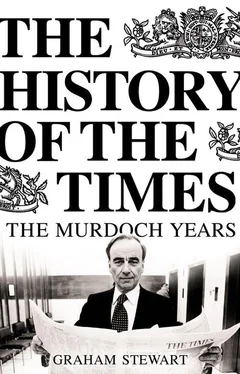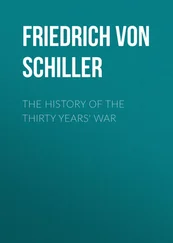It was hard to see what hard-headed businessman would leap at the opportunity to enter this environment. Certainly, there would be bidders with an interest in either asset stripping or wanting to turn The Times into a private toy. Middle Eastern backers expressed interest but, as Sir Richard Marsh, chairman of the Newspaper Publishers’ Association (NPA), indelicately put it: ‘I think [the idea of] The Times being owned by somebody in the Lebanon would be a joke.’ [4] UK Press Gazette , 27 October 1980.
Nearer home, there were some circling sharks, among them Robert Maxwell, James Goldsmith and Tiny Rowland, to whom the Thomson board were simply not prepared to sell the paper at any price. [5] Sir Gordon Brunton to the author, interview, 8 April 2003.
In Westminster there was cross-party alarm. Michael Foot, the Deputy Leader of the Labour Party, who had once been one of Beaverbrook’s sharpest pens, declared ‘every journalist in the country, I would think, would be deeply shocked at hearing the news’ that The Times was for sale or closure, adding: ‘undoubtedly this has created a crisis of major proportions for the free press in Britain’. [6] The Times , 23 October 1980.
The mood in the non-parliamentary wing of the Labour Movement was also glum. Meeting the members of the Thomson board two days after the announcement of the sale, Joe Wade, general secretary of the National Graphical Association (NGA) print union, whose members made up much of the skilled print labour force at TNL, said that the news ‘had wonderfully concentrated people’s minds’ and that in the last forty-eight hours he had been able to obtain a number of guarantees of continuous production. This was surprising. During 1978–9, his union had preferred to witness TNL’s papers being taken off the streets for eleven months rather than make concessions to its management. The shutdown of the papers had cost Thomson £40 million and ended only when management crumbled at the first sight of union guarantees that subsequently proved worthless. But now that his supposed antagonists appeared to be quitting the field, Wade changed his tune: ‘the Unions would prefer the Times titles to remain with The Thomson Organisation – better the devil you know’. The thirteenth-hour loyal protestation, if that is what it was, had come too late. The decision to sell was irrevocable. Wade unhelpfully commented to the press: ‘the unions frankly had grave doubts whether a realistic proposition would emerge for the transfer of the titles to a new owner’. [7] Times Archive, Box 9383.1.
In a rare moment of unity, the editor of The Times agreed. William Rees-Mogg had been in the chair since 1967, having been appointed shortly after Roy Thomson’s purchase of the paper from the Astor family. His father was a Somerset squire, but he was brought up in the Roman Catholic faith of his American mother, a former actress who in her day had performed alongside Sarah Bernhardt. Sent to school at Charterhouse, his precocious abilities won him a Brackenbury scholarship to Balliol College, Oxford, where he was at ease with the college’s temporal traditions; he was elected president of the Oxford Union. On going down, he worked first for the Financial Times and then at the Sunday Times as its deputy editor. He was still only thirty-eight when he became editor of The Times . Under his editorship the paper had continued to play to its strengths – in particular the authority of its comment and reflection on world events – while continuing to lag behind the Daily Telegraph in the breadth and immediacy of its home news coverage. In particular, Rees-Mogg had maintained the high standard of Times leader articles, the most memorable of which were his own work. As a seasoned commentator of the period put it with regard to Rees-Mogg’s paper: ‘One found oneself every morning in the company of a civilized, slightly barmy, humorous, usually gentle, intelligence, whose most stimulating characteristic was its unpredictability.’ [8] Patrick Marnham in Spectator , 20 February 1982.
This last facet was now to make itself evident as Rees-Mogg decided that it had fallen to him – with the journalists around him – to save The Times .
No sooner had the news of the sale broken than Rees-Mogg summoned his editorial staff. As many of the 330 full complement as could crowded around. His deputy, Louis Heren, described the occasion as ‘almost like a revolutionary commune’. [9] Louis Heren on Panorama , BBC TV, 17 November 1980.
If a ‘person of good character and quality’ wanted to buy the papers then that would be acceptable, Rees-Mogg declared. But merely switching ownership from one press baron to another should not be the ‘plan to save our future’. Thomson was offering The Times and Sunday Times for sale together as a package. This, Rees-Mogg argued, was a mistake. If anything was now clear it was that the two papers were ‘by their natures so different that neither paper is good for the other’. Not only did they have incompatible audiences, ‘the industrial logic which put the Sunday Times and The Times together was mistaken industrial logic’. In any case, ‘if the Thomson family were not able to master this business why should any other individual be any more successful?’. With the example of Le Monde , which was run by a journalists’ cooperative, the editor proposed bringing the already-formed staff group known as Journalists of The Times (JOTT), together with managers, as minority shareholders in a consortium supported by a variety of financial backers. Together they would buy the paper. [10] William Rees-Mogg, undated memo [22 October 1980], Box. 9335.
It was a bold idea. Some found the editor’s newfound conversion to worker participation perplexing, but others were enthusiastic. The paper’s Whitehall correspondent, Peter Hennessy, stood up to say, ‘I am very pleased about the powerful lead you intend to give us in our struggle and unwillingness to accept any Northcliffe-type buyer.’ Northcliffe had bought The Times from its original Walter family owners in 1908, popularizing it but interfering in its cherished editorial independence. He had also saved the paper from certain death. Within six years of Northcliffe’s acquisition of the paper, its circulation had risen from a mere 40,000 to 314,000 copies a day. It was a sign of what had happened under the two subsequent owners that, despite the massively expanding market during the twentieth century, this 1914 figure was higher than the 298,000 The Times was averaging between July and December 1980.
The Times of 23 October 1980 carried as its front-page lead story its own perilous position. Rees-Mogg wrote a signed article on the Op-Ed page (the page for columnists opposite the leaders and letters page) elaborating on his ideas in his speech to the staff. ‘Now The Times is going to fight for herself,’ proclaimed a new agenda: ‘the lesson of the Thomson years is that subsidy destroys the commercial operation of newspapers’ and that ‘I no longer believe in the virtue of a newspaper proprietorship which does not include the people who make the paper as shareholders in the ownership.’ ‘From now on,’ he announced, ‘the main thrust of my work will be to try with like-minded colleagues to develop a partnership – commercial not charitable – which can keep The Times in being.’ [11] William Rees-Mogg, ‘Now The Times is going to fight for herself’, The Times , 23 October 1980.
The paper’s letter page soon filled with exhortations from readers, often pledging the length of their active service to the paper’s circulation by way of qualification, in support of Rees-Mogg’s idea of a journalist-capitalist syndicate. [12] In particular, see The Times , letters page, 28 October 1980.
Barings became the project’s merchant bankers and Sir Michael Swann, Provost of Oriel College, Oxford, and a former chairman of the BBC, chaired the consortium. Lord Weinstock, managing director of GEC and a personal friend of Rees-Mogg, sat on its steering committee. If £10 million of working capital could be raised, fortified by £30 million a year revenue, it was certainly feasible that The Times could balance its books if it could cut its expenses by printing outside London’s notorious high labour costs. Lord Barnetson, the chairman of the Observer , had suggested to Rees-Mogg that printing The Times at a provincial ‘greenfield’ site could be done for £7 million a year. This was a third of the cost of doing it with the current TNL print workers at the paper’s London headquarters in Gray’s Inn Road. [13] Harold Evans, Good Times, Bad Times , pp. 97, 108.
Читать дальше












